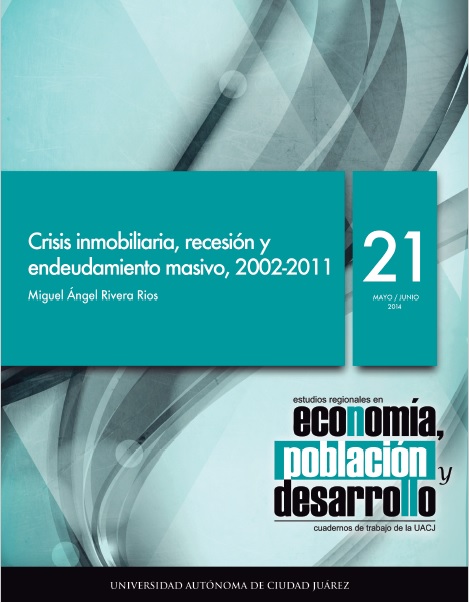Crisis inmobiliaria, recesión y endeudamiento masivo, 2002-2011
DOI:
https://doi.org/10.20983/epd.2014.21.1Palabras clave:
Crisis mundial, mercados financieros, capitalismo, Global crisis, financial markets, capitalismResumen
La crisis financiera mundial de la primera década del siglo XXI tuvo su origen en la creación y diversificación de instrumentos financieros respaldados por hipotecas que con el tiempo entraron en una fase de alto riesgo. Como parte de las perturbaciones de la crisis se promovió una restricción temporal del flujo de crédito, lo que provocó una recesión mundial en 2009; sin embargo la secuela de sobre-endeudamiento se extendió por el mundo desarrollado, afectando con particular virulencia a las economías más vulnerables de la Unión Europea en los siguientes años. En Islandia, Irlanda, Portugal. Grecia y España, la crisis siguió un patrón más o menos similar: colapso del sector inmobiliario, quiebras bancarias, su rescate con fondos públicos, sobre-endeudamiento, reducción forzada del déficit fiscal, desempleo, aumento de impuestos y devaluación de los bonos soberanos.
The global financial crisis of the first decade of the 21st century had its origin in the creation and diversification of financial instruments backed by mortgages that eventually returned on high risk derivatives. As part of the shocks of the crisis a temporary restriction of credit was one of the main causes of global recession in 2009. However, an over-indebtedness process was extended throughout the developed world, affecting the most vulnerable economies of the European Union with particular virulence. Iceland, Ireland, Portugal. Greece and Spain, are countries where the crisis followed a similar pattern: collapse of the real estate sector, bank failures, its rescue with public funds, over-indebtedness, reduction of the fiscal deficit, unemployment, increased taxes and devaluation of sovereign bonds.
Citas
Acharya, Viral. Matthew Richardson, Stijn. Van, Nieuwerburgh y Lawrence, White. (2011). Guaranteed to Fall. Fannie Mae, Freddie Mac and the Mortgage Finance, Princeton University Press, Princeton.
Dabat, Alejandro (2009). “La crisis financiera en Estados Unidos y sus consecuencias internacionales”, en Problemas del Desarrollo, vol. 40, núm. 157, abril-junio.
Dumas, Charles (2010). Globalisation Fractures. How Major Nations´ Interests are Now in Conflict, Profile Books, Londres.
Dumas, Charles y Diana Chyleva (2011). The American Phoenix and Why China and Europe Will Struggle After the Coming Slump, Profile Books, Londres.
Durbin, Michael (2011). All About Derivatives, McGraw Hill, Nueva York.
Ernst, Dieter (2010). “Innovación Offshoring en Asia: causas de fondo de su ascenso e implicaciones de política”, en Redes globales de producción, rentas económicas y estrategias de desarrollo: la situación de América Latina, M. A. Pozas, M. A. Rivera y A. Dabat (Coords.), El Colegio de México, México,
Gamble, Walton (2009). The Spectre at the Feast. Capitalist Crisis and the Politics of Recession, Palgrave, Londres.
Guttmann, Robert (1994). How Credit Shape the Economy. Sharp Inc., Nueva York.
Harvey, David (1990). Los límites del capitalismo y la teoría marxista, Fondo de Cultura Económica, México.
Hilferding, Rudolf (1973). El capital financiero, Ediciones El Caballito, México.
Kaplinsky, Raphael (2005). Globalization, Poverty and Inequality, Polity Press, Cambridge.
Keeley, Brian y Love, Patrick (2011). De la crisis a la recuperación. OCDE-UNAM. México.
Kindleberger, Charles (1989). Manías, Pánicos y Cracs. Historia de las crisis Financieras. Editorial Ariel, Barcelona.
Lenin, V. I. (1971). El imperialismo fase superior del capitalismo, en “Obras Escogidas”, ediciones Progreso, Moscú.
Marx, Carlos (1946). El Capital, Fondo de Cultura Económica, Tomo III, México.
McKinsey Global Institute (2010). Farewell to Cheap Capital? The Implications of Long Term Shifts in Global Investment and Saving, Diciembre.
Meghir, Costas, Vayanos, Dimitrios y Nikos Vettas (2010). The Economic Crisis in Greece. A Time of reform and Oportunity. www.greekeconomistforreform.com.
Minsky, Hyman P. (2010). “The Financial Instability Hypothesis: Capital Processes and the Behavior of the Economy”, en Financial Crisis: Theory, History and Policy, C. P. Kindleberger y J-P Laffargue (Eds.), , Cambridge University Press. Cambridge.
Minsky, Hyman P. (2008). Stabilizing as Unstable Economy, Mc Graw Hill, Nueva York.
Minsky, Hyman P. (1987). Las razones de Keynes, Fondo de Cultura Económica, México.
Patterson, Scott (2010). The Quants. How a New Breed of Math Whizzes Conquered Wall Street and Nearly Destroyed it, Crown Business, Nueva York.
Pérez Carlota (2004). Revoluciones tecnológicas y capital financiero. La dinámica de las grandes burbujas financieras y las épocas de bonanza, Siglo XXI Editores, México.
Reinhart, Carmen y Kenneth Rogoff (2011). Esta vez es distinto: ocho siglos de necedad financiera, Fondo de Cultura económica, México.
Shiller, Robert (2008). The Subprime Solution. How Today Global Financial Crisis Happened and What to Do About it, Princeton University Press, Princeton.
Stiglitz, Joseph (2011). Of the 1%, by the 1%, for the 1%, Vanity Fair, mayo.
Stiglitz, Joseph (2004). Los felices 90. La semilla de la destrucción. Taurus, México.
Tett, Gillian (2009). Fool´s Gold. The Inside Story of J. p. Morgan and How Wall St. Greed Corrupted Its Bold Dreams and Created Financial Catastrophe, Free Press, Nueva York.
The Economist (2012). The Spanish bail-Out, 16 de junio.
The Economist (2000). After the Gold Rush. Have the markets really punctured the dot.com bubble? 20 de abril.




